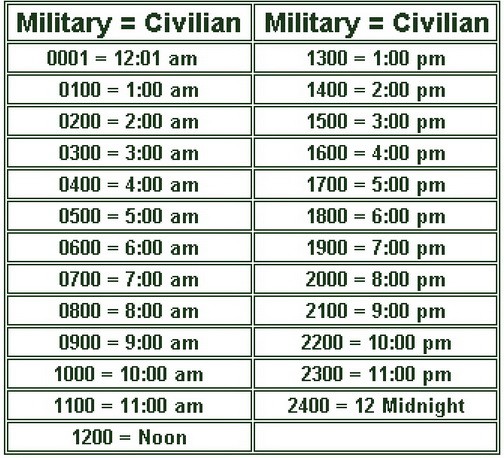Have you ever encountered military time and felt a bit confused? Perhaps you’ve wondered why it exists or how to quickly decipher it. This guide aims to be your ultimate resource, providing a detailed explanation of what military time is, its purpose, and simple methods for converting between standard and military time.
Military time, also known as a 24-hour clock, is a method of timekeeping where the day runs from midnight to midnight and is divided into 24-hour increments. It’s a standardized system widely used across various sectors globally.
Understanding the Military Time Chart
Here’s a handy chart to help you visualize the conversion between the 12-hour AM/PM clock and the 24-hour military time format:
| 12-hour am-pm clock | 24-hour military time |
|---|---|
| 12:00 midnight | 00:00 |
| 1:00 am | 01:00 |
| 2:00 am | 02:00 |
| 3:00 am | 03:00 |
| 4:00 am | 04:00 |
| 5:00 am | 05:00 |
| 6:00 am | 06:00 |
| 7:00 am | 07:00 |
| 8:00 am | 08:00 |
| 9:00 am | 09:00 |
| 10:00 am | 10:00 |
| 11:00 am | 11:00 |
| 12:00 pm | 12:00 |
| 1:00 pm | 13:00 |
| 2:00 pm | 14:00 |
| 3:00 pm | 15:00 |
| 4:00 pm | 16:00 |
| 5:00 pm | 17:00 |
| 6:00 pm | 18:00 |
| 7:00 pm | 19:00 |
| 8:00 pm | 20:00 |
| 9:00 pm | 21:00 |
| 10:00 pm | 22:00 |
| 11:00 pm | 23:00 |
| 12:00 midnight | 24:00 |
Decoding Military Time: A Step-by-Step Guide
In military time, the day begins at midnight, represented as 00:00. The last minute of the day is 23:59. You might occasionally see midnight written as 24:00; both are acceptable forms.
Consider this example: A schedule running from 4:00 pm to midnight in standard time would be written as 16:00 – 24:00 in military time. Furthermore, 10:15 am remains 10:15 in military time, while 2:30 pm converts to 14:30.
Simple Rules for Converting to and from Military Time:
-
Morning Hours (1:00 a.m. to 12:59 p.m.): These times are the same in both military and civilian time.
-
Afternoon and Evening Hours (1:00 p.m. and beyond): To convert standard time to military time, simply add 12 to the hour. For instance, 2:00 p.m. becomes 14:00 (12+2=14), and 10:00 p.m. transforms into 22:00 (10+12=22).
That’s all there is to it! It is quite simple.
Who Uses Military Time?
While the name suggests its primary use is within the armed forces, military time extends to various other domains:
- Military: Ensures clear, unambiguous communication, especially in operations.
- Government: Used in official documents and communications.
- Public Transportation: Helps in scheduling and coordinating transportation services.
- Hospitals: Crucial for accurate record-keeping and minimizing errors in patient care.
- Meteorologists & Astronomers: Facilitates precise data recording and analysis.
- Emergency Services: Enables quick and effective response coordination.
- Computers: It is used in data logging and system processes.
When verbally communicating military time, 07:00 can be pronounced as “zero seven hundred” or “oh seven hundred.” Within the military context, the colon is often omitted; hence, 07:52 would be written as 0752.
Furthermore, timestamps referencing Greenwich Mean Time (GMT), often interchanged with Coordinated Universal Time (UTC), are indicated by a “Z” at the end, like so: 0752Z. Local time is denoted by a “J,” and the Eastern time zone by an “R.” Each time zone has a corresponding letter designation.
 military time chart showing conversions
military time chart showing conversions
This image illustrates the conversion between standard and military time, showcasing the 24-hour format and its corresponding 12-hour equivalent.
In Conclusion
Understanding and using military time is easier than you might think. Its standardized format ensures clarity and reduces ambiguity, making it a valuable tool in various sectors. By grasping the simple conversion rules and understanding its applications, you can confidently navigate and utilize this timekeeping method effectively.
